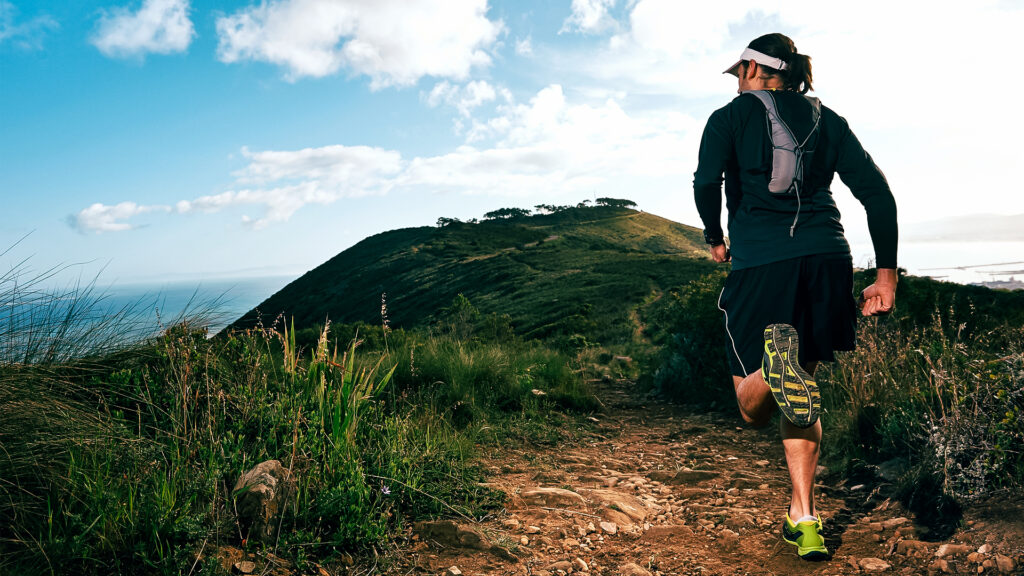Are you tired of pounding the pavement and longing for a new adventure in the great outdoors? Look no further than trail running! Trail running is an exhilarating sport that combines the physical challenge of running with the beauty and serenity of nature. Whether you’re a seasoned runner looking to switch up your routine or a beginner seeking a fresh fitness endeavor, trail running offers a unique and rewarding experience.
In this comprehensive guide, we will cover all the essentials you need to know to get started with trail running. From gear and preparation to technique and safety, we’ll provide you with valuable insights to help you hit the trails with confidence and joy. So, lace up your running shoes, take a deep breath of fresh air, and let’s dive into the exciting world of trail running!
Why Trail Running?
Trail running offers a refreshing break from the monotonous urban landscapes and crowded streets. It allows you to reconnect with nature while challenging your body and mind. The benefits of trail running go beyond physical fitness. Research has shown that spending time in nature can reduce stress, improve cognitive function, and enhance overall well-being. So, if you’re seeking an invigorating and fulfilling experience, trail running might just be the perfect fit for you.
Start Trail Running: The Essentials
Before hitting the trails, it’s essential to ensure you have the right gear and equipment. Here are some trail running essentials to consider:
Trail Running Shoes
Your choice of shoes can make or break your trail running experience. Unlike road running shoes, trail running shoes provide better traction, stability, and protection against uneven terrain. Look for shoes with a lugged outsole for enhanced grip, a protective toe cap, and sufficient cushioning to absorb impact. Brands like Salomon, Altra, and Merrell offer a wide range of trail running shoes suitable for different terrains and foot types.
Moisture-Wicking Clothing
Trail running often involves varying weather conditions and intense physical exertion, so wearing moisture-wicking clothing is crucial to keep you dry and comfortable. Opt for breathable and quick-drying materials like polyester or merino wool that wick away sweat from your body. Dress in layers to adapt to changing temperatures and weather conditions.
Hydration Pack or Water Bottle
Staying hydrated during your trail runs is vital for maintaining performance and preventing dehydration. Depending on the duration of your run, consider carrying a hydration pack or a handheld water bottle. Hydration packs are backpack-like systems with a bladder and drinking tube, allowing you to sip water without breaking your stride. If you prefer a handheld option, choose a water bottle specifically designed for running with an ergonomic shape and a strap for easy carrying.
Navigation Tools
When venturing into unfamiliar trails, it’s crucial to have the means to navigate your way. Consider carrying a trail map, compass, or a GPS device to help you stay on course. Additionally, smartphone apps like AllTrails and ViewRanger provide detailed trail maps and GPS tracking, ensuring you won’t get lost on your adventure.
Sun Protection
Don’t forget to protect yourself from the sun’s harmful rays while trail running. Apply a sweat-resistant sunscreen with an SPF of at least 30 to exposed skin, including your face, neck, and arms. Wear a lightweight hat or a visor to shield your face from direct sunlight, and don’t forget to wear UV-protective sunglasses to safeguard your eyes.
Trail Running Accessories
Several accessories can enhance your trail running experience and provide added convenience. Consider investing in a lightweight and breathable running hat or buff to manage sweat and keep your hair in place. Compression socks or calf sleeves can aid in muscle recovery and reduce fatigue. A lightweight running backpack or waist pack can help you carry essentials like snacks, a mobile phone, and additional layers of clothing. Don’t forget to pack a small tube of trail-specific sunscreen and insect repellent for extended runs in varying terrain and weather.
Preparing for the Trail
Proper preparation is key to a successful and enjoyable trail running experience. Here are some essential steps to take before hitting the trails:
Research the Trail
Take the time to research and familiarize yourself with the trail you plan to run. Look for online resources, trail guidebooks, or local running groups that can provide valuable information about the trail’s difficulty level, terrain, elevation gain, and any potential hazards. Understanding the trail beforehand allows you to plan your run accordingly and set realistic expectations.
Check the Weather
Weather conditions can significantly impact your trail running experience and safety. Check the weather forecast for the area and time of your run to ensure you dress appropriately and make any necessary adjustments to your plan. Be prepared for unexpected changes in weather and carry extra layers or rain gear if needed.
Trail Safety
Trail running comes with its own set of risks, so it’s crucial to prioritize safety. Be aware of any potential hazards such as steep drop-offs, loose rocks, or slippery surfaces. Pay attention to trail markers and signage, and avoid deviating from established trails unless you’re confident in your navigation skills. Familiarize yourself with basic first aid techniques and carry a whistle or other signaling device in case of emergencies.
Inform Someone
Before heading out on your trail run, inform a trusted friend or family member about your plans. Share details such as the trail you’ll be running, your estimated time of return, and any emergency contacts. In the unlikely event that something goes wrong, having someone who knows your whereabouts can be invaluable.
Stretching and Warm-up
Proper warm-up and stretching exercises are essential to prevent injuries and optimize performance. Before starting your trail run, perform dynamic stretches that target key muscle groups like the calves, quadriceps, and glutes. Engage in a light jog or brisk walk for a few minutes to raise your heart rate and increase blood flow to your muscles.
Trail Etiquette
Respecting the trail and other users is essential for maintaining a positive trail running experience. Practice trail etiquette by yielding to hikers and slower runners, especially on narrower sections of the trail. When passing, announce your presence politely or use a bell to alert others. Avoid littering and leave no trace by packing out any waste you generate. By following these principles, we can ensure the sustainability and enjoyment of trails for everyone.

Trail Running Technique
Mastering the proper technique can enhance your trail running performance and reduce the risk of injuries. Here are some key elements to focus on:
Uphill Running
When tackling uphill sections, maintain an efficient and controlled running form. Lean slightly forward from the ankles, engage your core muscles, and take shorter strides to conserve energy. Focus on maintaining a steady rhythm and consider using your arms to assist in propelling yourself uphill.
Downhill Running
Running downhill can be exhilarating but also challenging. Maintain a slightly leaned-forward posture to control your descent. Take shorter strides and let gravity do the work, avoiding the temptation to brake excessively. Keep your eyes on the trail ahead to anticipate any obstacles and adjust your foot placement accordingly.
Navigating Technical Terrain
Trails often present varying terrains, including rocky sections, tree roots, and uneven surfaces. Maintain a nimble and light-footed approach by picking your feet up and maintaining a high cadence. Use your arms for balance and stability, allowing them to move naturally with your running motion.
Pacing Yourself
Trail running involves continuous variations in terrain and elevation, making it important to pace yourself accordingly. Avoid starting too fast and burning out early in your run. Instead, maintain a consistent effort level and adjust your pace to accommodate changes in the trail. Embrace the natural rhythm of the trail, and remember that slower sections or inclines are opportunities to catch your breath and recover.
Breathing Techniques
Proper breathing techniques can help you maintain endurance and stay relaxed on the trail. Focus on deep belly breathing rather than shallow chest breathing. Inhale deeply through your nose, expanding your diaphragm, and exhale fully through your mouth, releasing tension with each breath. Find a breathing rhythm that feels comfortable and allows you to maintain a steady effort.
Proper Foot Placement
Pay attention to your foot placement to avoid tripping or stumbling on the trail. Aim to land with a midfoot or forefoot strike to maximize stability and reduce the risk of ankle sprains. Be mindful of your stride length, adjusting it based on the terrain to maintain balance and control. Lift your feet slightly higher than you would on a flat surface to clear any potential obstacles.

Trail Running Safety
Safety should always be a top priority when trail running. Here are some key safety tips to keep in mind:
Stay Alert and Aware
Maintain a high level of awareness of your surroundings while on the trail. Stay focused and avoid distractions like headphones that can impair your ability to hear approaching wildlife, other trail users, or potential hazards. Be observant of changes in the trail and anticipate any obstacles or changes in terrain.
Wildlife Encounters
Encounters with wildlife can be awe-inspiring but also potentially dangerous. Research the area you’ll be running in to understand the wildlife that may inhabit it. If you encounter a wild animal, maintain a safe distance and avoid sudden movements. Make noise to alert animals of your presence and give them space to move away. Familiarize yourself with best practices for specific wildlife encounters, such as bears or snakes, and know how to react appropriately.
Carry a First Aid Kit
Having a basic first aid kit is essential for handling minor injuries or emergencies on the trail. Include items such as adhesive bandages, gauze pads, antiseptic wipes, blister treatments, and a compression bandage. Familiarize yourself with how to use the items in your kit before hitting the trail.
Emergency Communication
In case of emergencies, it’s crucial to have a means of communication. Carry a fully charged mobile phone with you, but be aware that there may be areas with limited or no reception. Consider investing in a personal locator beacon (PLB) or a satellite communication device if you frequently venture into remote areas with no cell coverage.
Trail Running with a Buddy
Running with a trail running partner not only enhances the social aspect but also improves safety. Having a companion provides an extra set of eyes and can be crucial in case of emergencies. If running alone, inform someone about your plans and expected return time.
Listen to Your Body
Your body knows best, so pay attention to any signs of fatigue, pain, or discomfort. Don’t push through injuries or excessive fatigue, as this can lead to more severe problems. Take breaks when needed, refuel with snacks and water, and adjust your pace or distance if necessary. Listening to your body and practicing self-care will ensure a more enjoyable and sustainable trail running journey.
Frequently Asked Questions
Can I use regular running shoes for trail running?
While regular running shoes can be used for light trail running on non-technical terrain, trail running shoes are recommended for optimal performance and safety. Trail running shoes provide better traction, stability, and protection against uneven surfaces and obstacles commonly found on trails.
How do I choose the right trail running shoes?
When choosing trail running shoes, consider factors such as the type of terrain you’ll be running on, your foot shape, and personal preferences. Visit a specialty running store for expert advice and get properly fitted. Try on different models, walk around, and simulate running movements to assess comfort and fit. Consider the amount of cushioning, the level of stability or pronation control, and the grip of the outsole.
Do I need special socks for trail running?
While not absolutely necessary, wearing trail-specific socks can provide additional comfort and protection. Trail running socks are often made of moisture-wicking materials and provide extra cushioning in key areas. They also tend to have reinforced toe and heel areas to minimize friction and reduce the risk of blisters.
Should I carry water with me while trail running?
Staying hydrated is essential during trail running, especially on longer or more challenging runs. If the trail offers access to water sources, you may opt to carry a lightweight water filter or purification tablets instead of carrying a large quantity of water. However, for runs where water sources are scarce, a hydration pack or handheld water bottle is recommended.
How can I prevent blisters while trail running?
Blisters can be a common issue when trail running due to increased friction and moisture. To prevent blisters, ensure your shoes fit properly and aren’t too tight or too loose. Wear moisture-wicking socks and consider using blister prevention products such as lubricants or adhesive patches. Stop and address any hot spots or discomfort immediately by applying moleskin or a blister bandage.
Is it necessary to carry a trail map or GPS device?
Carrying a trail map or GPS device is highly recommended, especially when running on unfamiliar trails or in remote areas. These tools help you navigate the trail, avoid getting lost, and make informed decisions if you encounter any junctions or alternate routes. Mobile apps like AllTrails or ViewRanger can also provide detailed trail maps and GPS tracking, often accessible offline.
Is Trail Running Bad For Your Ankles?
Trail running involves navigating uneven terrain, which can put stress on your ankles. However, when done with proper technique and precautions, trail running is not inherently bad for your ankles. In fact, it can help strengthen the muscles and ligaments around your ankles, making them more resilient.
Trail running requires your ankles to constantly adjust and stabilize on uneven surfaces, which can help improve ankle strength, stability, and proprioception. The varying terrain challenges your ankles in different ways, engaging the muscles in your lower legs, including the calves, shins, and ankles. Over time, this can lead to stronger ankles and a reduced risk of ankle sprains or injuries.
To minimize the risk of ankle issues while trail running, it’s important to take the following precautions:
- Choose proper footwear: Invest in a pair of trail running shoes that provide ankle support and have a stable sole. Look for shoes with a sturdy construction and ankle collars that offer extra protection.
- Strengthen your ankles: Incorporate ankle-strengthening exercises into your training routine. Simple exercises like calf raises, ankle circles, and single-leg balances can help improve ankle stability and strength.
- Gradually increase intensity: Start with easier trails and gradually progress to more challenging terrain as your ankles adapt. Allow your ankles time to strengthen and adjust to the demands of trail running.
- Pay attention to foot placement: Focus on where you’re placing your feet to avoid rolling or twisting your ankles. Be mindful of roots, rocks, or other potential hazards on the trail.
- Listen to your body: If you experience pain or discomfort in your ankles, it’s important to listen to your body and take appropriate rest and recovery measures. Don’t push through pain, as it can lead to more severe issues.
By taking these precautions and gradually building strength and stability in your ankles, trail running can be a safe and effective way to improve overall fitness while enjoying the beauty of nature.
Will Trail Running Build Muscle?
Yes, trail running can build muscle and contribute to overall muscle development. The varied terrain and elevation changes in trail running engage a wider range of muscles compared to running on flat surfaces. Here’s how trail running can help build muscle:
- Leg Muscles: Trail running targets the muscles in your lower body, including the quadriceps, hamstrings, calves, and glutes. Uphill sections and uneven terrain engage these muscles more intensively, leading to increased muscle activation and strength development.
- Core Muscles: Maintaining balance and stability on uneven trails requires engagement of your core muscles. Your abdominals, obliques, and lower back muscles work to stabilize your body and maintain proper form while navigating challenging terrain.
- Ankle and Foot Muscles: The constant adjustments and balance required during trail running strengthen the muscles in your feet and ankles. These muscles play a vital role in maintaining stability and absorbing impact.
- Upper Body Muscles: While trail running primarily focuses on the lower body, the upper body also plays a role in maintaining balance and momentum. The swinging motion of your arms and the engagement of your shoulder and back muscles contribute to overall muscle activation.
To maximize muscle development through trail running, consider incorporating the following strategies:
- Interval Training: Incorporate intervals of higher intensity, such as hill sprints or short bursts of increased speed, to engage muscles more intensely and promote muscle growth.
- Strength Training: Combine trail running with strength training exercises to target specific muscle groups and enhance overall strength and endurance. Exercises like squats, lunges, and plyometric movements can complement your trail running routine.
- Proper Nutrition: Fuel your body with a balanced diet that provides adequate protein for muscle repair and growth. Ensure you’re consuming enough calories to support your training and recovery needs.
Remember to start gradually and listen to your body to avoid overuse injuries. Vary your trail routes and challenge yourself with different terrains to engage different muscle groups. By incorporating trail running into your fitness routine and following proper training principles, you can build muscle, improve overall strength, and enjoy the exhilarating experience of trail running.
Conclusion
Trail running offers a thrilling and immersive way to connect with nature while reaping the numerous benefits of exercise. By following the trail running essentials, preparing adequately, mastering proper technique, and prioritizing safety, you can embark on a fulfilling trail running journey. Remember to respect the trail, be mindful of your surroundings, and listen to your body. So lace up your trail running shoes, hit the trails, and enjoy the incredible experience of trail running.


Recent Comments